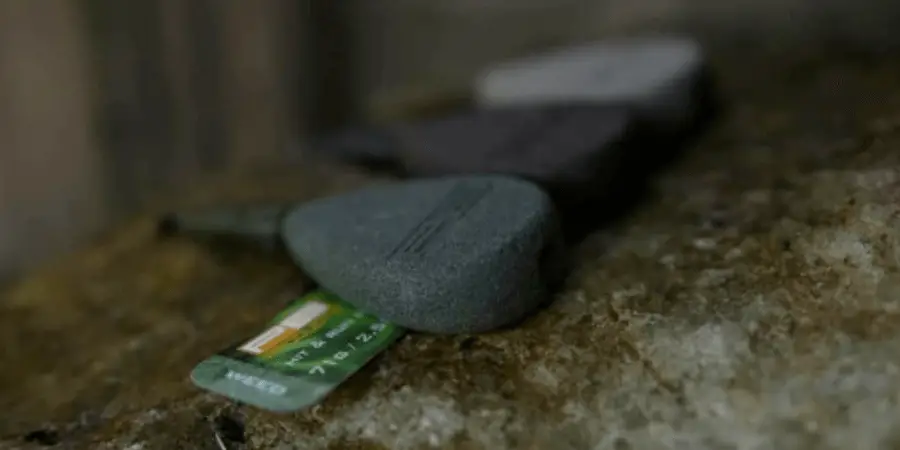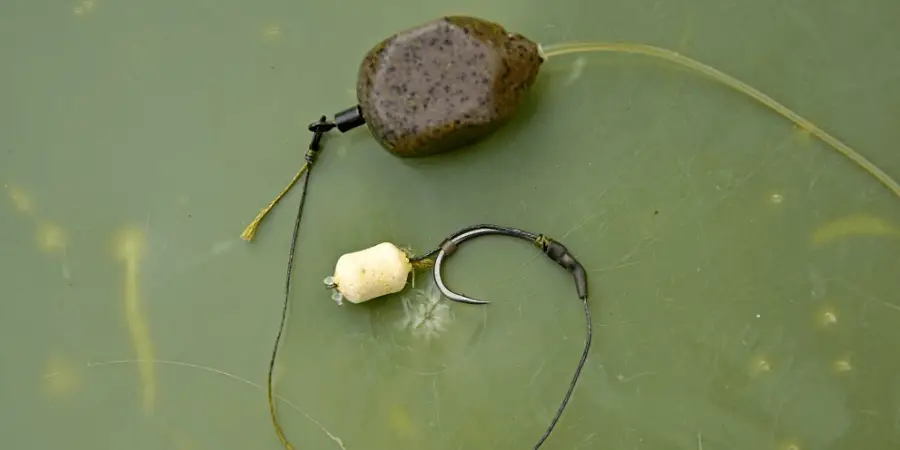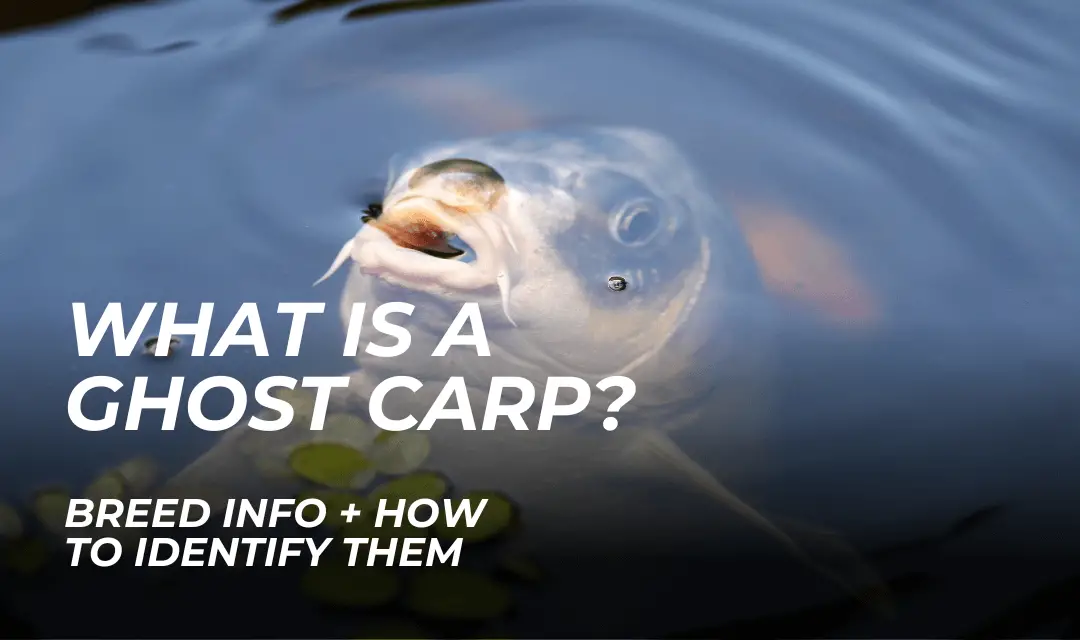There are lots of different lead setups available on the market, each providing their own purpose in certain carp fishing scenarios. One of the most commonly used is an inline lead setup, otherwise known as an inline lead rig.
Using an inline lead in the the right situation can be a game changer, improving your hook holds and overall catch rate. Use it in the wrong situation, such as fishing in deep silt, and it can work against you.
Let’s find out more about what it is and when you should use an inline lead.
What is an Inline Lead Setup?
An inline lead setup is a specially designed carp lead which your line passes through. Instead of having a swivel, you have a hollow centre, and it sits just above your hooklink.
Essentially, it’s an alternative to a traditional lead which you would mount via a lead clip or helicopter setup.

What are the benefits of using inline leads?
Improved Hook Holds
With the way that inline leads are mounted, the hooklink comes into direct connection with the lead fast. This is excellent for hooking carp, as the pressure of the lead helps to bury the hook.
For this reason, inline leads are commonly used in stalking situations, where carp may be feeding shyly in the edge.
The Fox Edges Inline Lead System is one of the safest on the market, enabling the lead to drop on the take.
- Benefit from the awesome hooking properties of an inline lead
- Be able to drop the lead on the take
Neat & Tidy
Once constructed, an inline lead system provides a neat and tidy setup, free of any other moving or bulky parts such as a lead clip set up. Inline leads are therefore the number one lead arrangement for use in solid PVA Bags, where space in minimal.
In addition, when using PVA bags the carp is predominantly feeding around the lead arrangement, so you want it as minimal as possible.
Aerodynamic
Although not synonymous with distance casting, inline leads do tend to fly true through the air, as the weight is in direct proportion with the line.
When to use an inline lead rig?
There are a few situations where an inline lead rig can be really beneficial for your angling. Here’s just a few:
Solid PVA Bag Fishing
As we have briefly touched on, inline leads are predominantly used in solid PVA bag fishing. They’re compact, neat and providing excellent hooking capabilities. – A must when carp are feeding on smaller solid bag items. Solid PVA Bags are particularly useful when carp fishing in heavy weed, as the whole setup can plunge straight through the weed and be presented on the lakebed.
Stalking
We already know that inline leads provide excellent hooking capabilities. For that reason, they are often a key choice for stalking or fishing in the edge. When you can see that your bait is accurately positioned and not plugged into the lakebed, why would you not opt for a lead that provides a superior hook hold.
When it comes to fishing in the edge, an inline lead fished ‘drop-off’ style is the choice for us.

When not to use an inline carp lead?
As good as they can be, there are times when you should opt for another lead arrangement over an inline lead. Here are just a few examples:
Fishing in deep silt
Out of all of the lakebed makeups, silt is potential the hardest to accurately fish over. Any lead arrangement will have a tendency to plug into the silt, but it happens more so with inline leads.
As the lead is directly connected to the hooklink, it’s very easy for the lead to pull your hooklink and hookbait into the silt. From a fishing point of view this is disastrous, completing burying your hookbait out of view of passing carp.
A key part of carp fishing is to actually make sure that your hookbait is accessible. If you want to do that in silt, stay away from inline leads! (Unless you’re using them in solid PVA bags).
When you’re not sure what the lakebed is
Let’s say you turn up to a lake and have no idea of the lakebed. In this instance, an inline lead is a gamble as you could be fishing on a soft lakebed. Inline leads have a tendency to plug into the lakebed, bringing your hooklink down with it too.
For scenarios where you’re casting into the unknown, we recommend opting for a chod rig every time.
Are inline leads safe?
Most items of carp tackle are safe in the right hands, and that includes inline leads. Inline leads are safe as long as the lead can come off the end of the leader/line in the event of a crack-off or line break. (This is the case for all lead arrangements).
The last thing you want is a carp trailing a 3-4oz inline lead around.
How to make your inline lead safer
The problem with traditional inline leads is that the centre tube is very slim and built from a tough plastic material. When used in conjunction with leadcore or a fluorocarbon leader, it leaves little room to be able to fall off in the event of a breakage.
For that reason, we recommend removing the inner tubing and replacing with a tail rubber. These are much more supple and tend to sit easier on your hooklink swivel.
Alternatively, you can opt to fish a drop off inline lead. This involves having your leadcore pass on the outside of the lead, so that it can easily pull away from the swivel and tail rubber in the event of a take.
MORE READING: What is a leader in carp fishing?
Using an inline lead like a running rig
Something I have been having success with over the last season is using an inline lead loose so that is basically free to run up and down your leader. – Similar to an old school running rig.
The result has been a rig which benefits from the great hooking potential initially, but then runs free, giving a carp no chance to use the lead to help eject the hook.
Much like running rigs, the takes have been savage. Complete one toners.
Truth be told, fishing liek this was completely accidental. I purchased the wrong sized PVA bag stems and they wouldn’t fit snugly into my inline leads.
Either way, It’s been an eye-opener for me when fishing with my solid PVA bags.
How to set up an inline lead
About the writer

Rob W
I’m Rob, Carp Squad’s main contributor. I’ve been carp fishing on and off for 15 years, but the bug is well and truly back at the moment. Hopefully the articles I write on here help you put more carp on the bank.


![Stocks Lake Norton Disney [Tips & Tactics]](https://carpsquad.com/wp-content/uploads/2023/11/stocks-lake-norton-disney-2-1.png)

